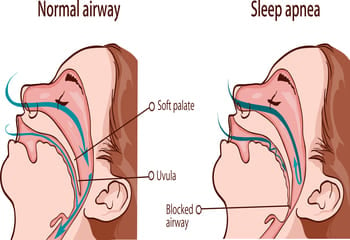Describe sleep apnea
It is considered a severe medical condition in which the patient stops breathing for a few seconds while asleep. Such pause in breathing can last for ten seconds or more.
How many types of sleep apnea are there?
The Obstructive Sleep Apnea (OSA), Central Sleep Apnea (CSA), and Mixed Sleep Apnea are the three types of the disorder.
- OSA involves the blockage of the airways for ten seconds or more while the person is asleep.
- CSA has to do more with the brain's medical condition. It happens when the brain fails to send signals to control the breathing-related muscles.
- Patients suffering from Mixed Sleep Apnea show symptoms of both, OSA and CSA.
Sleep apnea is caused by
- Age factors
- Heart disorders
- Reaction to medications
- Consumption of alcoholic products
- A narrowed airway
- Excess weight/obesity.
In kids, it can be caused due to dental conditions, a tumor in the airway, enlarged tonsils, and congenital disabilities like Down syndrome.

Sleep apnea stomach problems
Research suggests that some patients suffering from OSA often suffer from stomach cramping, bloating, and chronic diarrhea. A link has also been found between physiologic stress and OSA.
Can babies get sleep apnea?
Infants may suffer from obstructive, central, or mixed sleep apnea. However, these breathing problems can prove to be much more complicated for infants compared to adults. If left untreated, the insufficient oxygen supply can cause medical conditions like bradycardia and hypoxemia.
Sleep apnea treatment medication
The oral appliance therapy (OAT) and the use of airway pressure machines along with breathing masks are the most recommended primary treatment options. Prescribing medications is looked at as the second alternative. A physician may recommend wakefulness-promoting drugs containing modafinil, armodafinil.
The list of other prescribed medicines to offer aid in sleep includes benzodiazepines, barbiturates, melatonin receptor agonists, and non-benzodiazapine hypnotics class drugs.
Difference between sleep apnea and obstructive sleep apnea
The upper respiratory tract (upper airways) gets blocked for a few seconds in OSA. On the other hand, in CSA, the brain stops sending signals to breathing muscles resulting in a disruption in sleep.
Best sleeping position for sleep apnoea
Avoid lying on the back and try sleeping on your side to control sleep apnea.



